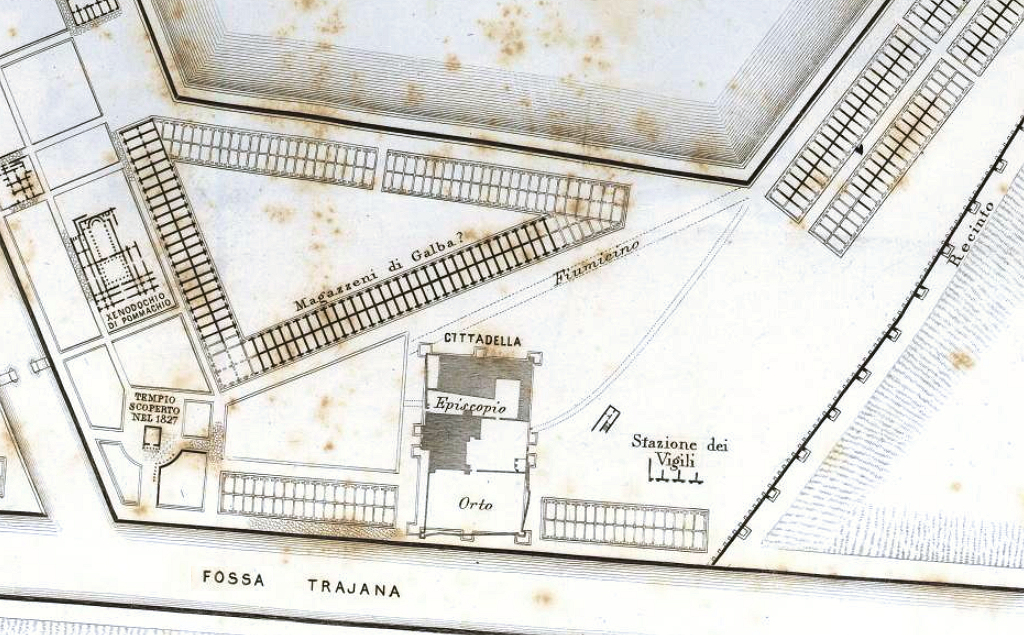Vigiles from Rome were stationed for periods of four months in both Ostia and Portus. In 1868 Rodolfo Lanciani reported the discovery of inscriptions of the vigiles in Portus, and of some walls that probably belong to their barracks: "Almost all the inscriptions just mentioned were extracted from the ruins of a considerable building divided into cells and belonging to the Antonine era. In it, therefore, I would not hesitate to recognize the station of the vigiles, all the more because a very large tabula lusoria was also found there, a usual pastime of the soldiers, and of which an example was also found in the military station at Ostia, also divided into cells for use in the camp.(1) The statio of the vigiles in Portus, if my conjecture is true, would be situated on the right bank of the fossa Traiana, between the citadel (now Episcopio) and the city walls".
 |
The location of the barracks of the vigiles in Portus.
Detail of Monumenti inediti 8 (1868), Tav. XLIX.
Two of the inscriptions are religious dedications, found together. The first mentions an altar that was set up for Fortuna Domestica, for the well-being and safe return of Septimius Severus and Clodius Albinus. It was the work of officers from the second and fourth cohort of the vigiles. The second inscription mentions Hercules, and Lanciani adds: "The statue of Hercules mentioned in the inscription was actually found at a short distance; and although it was shattered, it was almost completely recomposed, and is now believed to form one of the best ornaments in the emerging Torlonia museum".(2) It was, once again, the work of officers from the second and fourth cohort.
|
FORTVNAE DOMESTICAE SAN CTAE ARA(m) PRO SALVTE ET REDITV L(uci) SEPTIMI SEVERI PERTINACIS AVG(usti) [et D(ecimi) Clodi] SEPTI [mi Albini Caesaris] L(ucius) VALERIVS FRONTINVS (centurio) COH(ortis) II VIGIL(um) SVA PECVNIA POSVIT CVM SVIS A(-rius?) L(eo?) ET V(arius?) F(uficianus?) I(---) FL(avius) IVLIANVS CEN(turio) CO(ho)R(tis) IIII VIGILI |
To Fortuna of the house, sacred, the altar for the well-being and the return of Lucius Septimius Severus Pertinax, Augustus, [and of Decimus Clodius Septimius Albinus, Caesar], Lucius Valerius Frontinus, centurion of the second cohort of the fire-fighters at his own expense, placed with his men, A... L... and V... F... I..., Flavius Julianus, centurion of the fourth cohort of the fire-fighters. |
| Marble base, found in Portus. Text below two cornucopiae. Date: 196-197 AD. Meas. 0.90 x 0.41 x 0.32. CIL XIV, 6; EDR147042. |
|
|
[---]I HERCVLI [C]ASSIVS LIGVS TRIB(unus) COH(ortis) IIII VIGIL(um) D(onum) D(edit) CVRAM AGENTI[bus] VALERIO FRONTIN[o (centurione) co]H(ortis) II VIGIL(um) ET VARIO FVFICIANO [---]RIO LEONE AEMILIO CATVLLINO [---] (centurione) AGENTIBVS |
To Hercules [---]. Cassius Ligus, tribune of the fourth cohort of the fire-fighters, offered this gift, taking care of it Valerius Frontinus, centurion of the second cohort of the fire-fighters and Varius Fuficianus, [---]rio Leo and Aemilius Catullinus [---], centurion, being agents. |
| Marble base, found in Portus. With a relief of a vessel and a club. Date: 195-200 AD. CIL XIV, 13; EDR147053. |
|
Some of the same officers are found in a third inscription. In a fourth inscription we find an officer from the fifth cohort. In this inscription we also encounter the word castra: the vigiles in Portus used a military camp. Presumably they lived here.
|
[Cassius] LIG[us trib(unus) coh(ortis) IIII vigil(um)] [praep(ositus) vexil]LAT[ionis ---] [--- cur]AM AGE[ntibus] [Valerio Fro]NTINO [(centurioni) coh(ortis) II] [vigil(um) et V]ARIO FV[ficiano ---rio] [--- Leo]NE AEMI[lio Catullino ---] AGEN[tibus] |
L(ucius) VALERIVS [---] CEN(turio) COH(ortis) V AGENTI[bus] [---]EA CASTRA VI[gilum?---] [---]OB EA PRO[---] |
| Marble base or slab, found in Portus. Date: 195-200 AD. CIL XIV, 14; EDR147054. |
Marble base or slab, found in Portus. Date: 195-230 AD. CIL XIV, 15; EDR147055. |
A bit surprising are the contents of a funerary inscription from the Isola Sacra necropolis of Portus. It records the burial of the foster-child, Atenius, of Aurelius Crescens, centurio from the third cohort, and his wife Iulia Manteiane. Perhaps the mother had rented an apartment or lived with relatives, because of the child's illness and to be close to the father. The father would have lived in the castra or with his wife and son.
|
D(is) M(anibus) HIC IACET EXANIMIS PVER NOMINE ATENIO QVI VIXIT ANIS XVIII MESIS VIII DIEBVS VIII AVREL(ius) CRESCES (centurio) COH(ortis) III VIG(ilum) IVLIA MANTEIANE PRATRONI CARISIMO AIVMNO FEC(erunt) |
 |
| Marble slab, found in 1938 in tomb 134, Isola Sacra necropolis. Date: second half of the second century? Thylander A31; EDR101700. Photo: EDR. |
It has been suggested that a Christian funerary inscription from Portus, dated to 386 AD, records the names of two vigiles. It also mentions Ostia. In the inscription an unequivocal reference to the fire-fighters is, however, missing.
|
Fl(avio) HONORIO N(obilissimo) P(uero) ET FL(avio) ☧ EVBODIO CONSS FAVIIS ADEODATO CENT(urioni) COH(ortis) VII ET CRI[spin? ---]O COH(ortis) II A CIV [ita]T(e) OSTIA ON |
| Funerary inscription, found in Portus. At the end of the first line is the chi-rho monogram. BullArchCrist 1866, 51; Meiggs 1973, 308. CIL XIV, 231; EDR149626. |
Notes
(1) Lanciani 1868, 188. For the "military station" at Ostia Lanciani refers to C.L. Visconti 1857, 308. The building in Ostia is not the Barracks of the Fire Brigade, but a double row of rooms set against the city wall, outside the Porta Secondaria of Via dei Sepolcri.
(2) On page 172 Lanciani mentions the Temple of Hercules in the area of the Imperial Palace of Portus. See the description of that building for more information. Here a fragmented statue of Hercules was found. It looks therefore as if the statue is assigned to two locations.